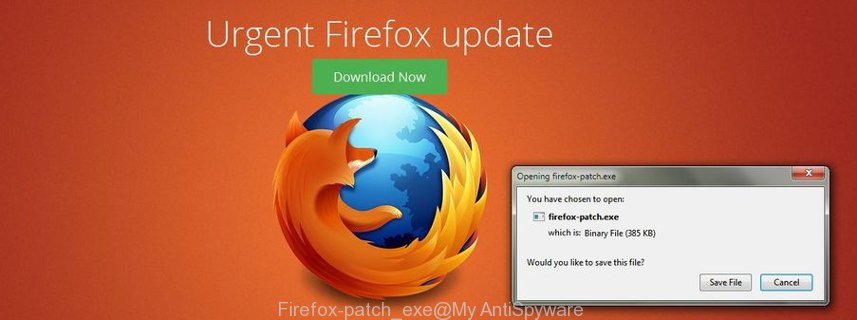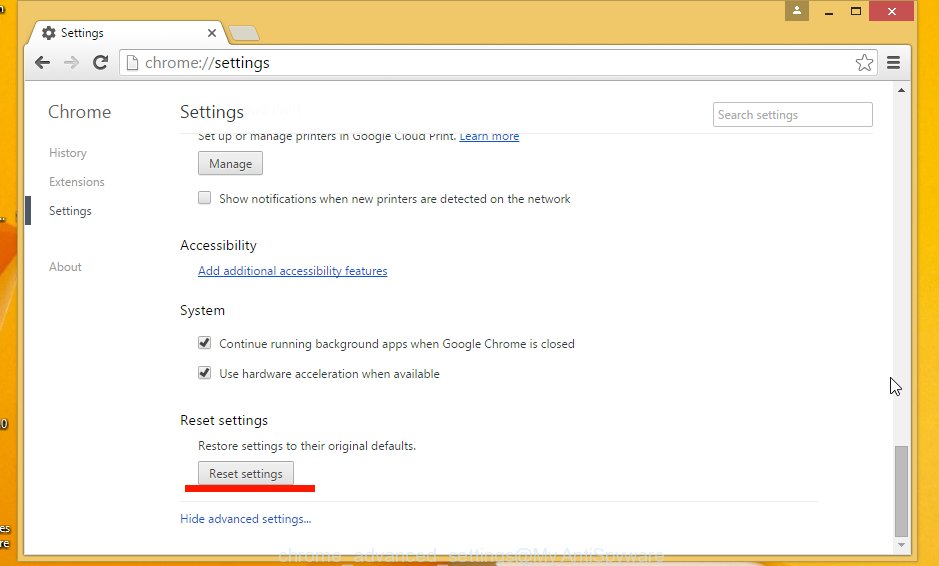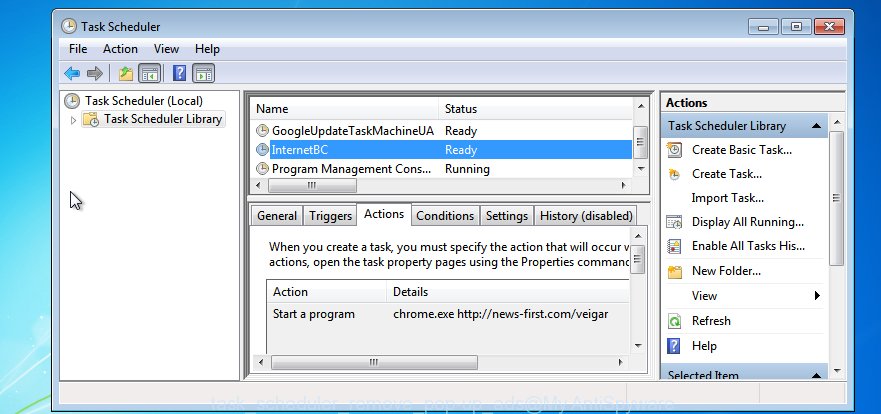The appearance of annoying Firefox-patch.exe popup asking to install a “Firefox Update” in your browser means that your computer is infected with an ‘ad-supported’ software (also known as adware). It makes changes to the computer settings and configures itself so as to start automatically each time the computer is turned on. Immediately after startup, the ad-supported software begins to monitor the user’s actions and insert ads directly into the open windows of the Chrome, Mozilla Firefox, Internet Explorer and Edge. So, if you notice that your browser has become open this site, then you do not need to wait , you need to follow the step-by-step guide below and remove Firefox-patch.exe pop-ups as quickly as possible.

The adware usually affects only the FF, Chrome, Microsoft Internet Explorer and Microsoft Edge by changing the browser’s settings or installing a malicious extensions (addons). Moreover, possible situations, when any other web browsers will be affected too. The adware will perform a scan of the computer for web browser shortcuts and modify them without your permission. When it infects the internet browser shortcuts, it’ll add the argument like ‘http://site.address’ into Target property. So, each time you open the browser, you will see an annoying Firefox-patch.exe misleading web page.
While your personal computer is infected with the ‘ad supported’ software, your web-browser may be redirected to Firefox-patch.exe annoying web-page. Of course, the adware may not cause damages to your files or Windows system, but it may display a large number of annoying advertisements. These ads will be injected within the content of web-pages that are you opening in your browser and can be varied: pop-up ads, in-text ads, different sized banners, offers to install an questionable software. The advertisements will appear on all web sites, including web-pages where previously you have never seen any advertising banners.
We suggest you to get rid of adware and clean your personal computer from Firefox-patch.exe pop-up virus as quickly as possible, until the presence of the ad-supported software has not led to even worse consequences. You need to follow the step-by-step guide below that will allow you to completely remove the redirect to Firefox-patch.exe misleading page, using only the built-in Windows features and a few of specialized free tools.
How did you get infected with Firefox-patch.exe pop-up malware
Probably, the adware get installed onto your PC system when you have installed a free programs like E-Mail checker, PDF creator, video codec, etc. Because, most commonly the adware is bundled within the install packages from Softonic, Cnet, Soft32, Brothersoft or other similar web-sites. Even removing the program that contains ‘ad supported’ software, does not help you delete the Firefox-patch.exe pop-ups. Therefore, you must follow the steps below to get rid of all annoying popups.
How to manually remove Firefox-patch.exe pop-ups
This steps will assist you remove Firefox-patch.exe pop-up from your internet browser. These Firefox-patch.exe malware removal steps work for the Google Chrome, Microsoft Internet Explorer, Mozilla Firefox and Microsoft Edge, as well as every version of Windows operating system. Some of the steps may require you to close the internet browser or reboot your machine. So, bookmark or print it for later reference.
- Delete suspicious and unknown programs by using Windows Control Panel
- Disinfect the browser’s shortcuts to get rid of Firefox-patch.exe redirect
- Remove Firefox-patch.exe from Mozilla Firefox
- Delete Firefox-patch.exe pop-ups from Chrome
- Remove Firefox-patch.exe pop-ups from Internet Explorer
- Get rid of unwanted Scheduled Tasks
Delete suspicious and unknown programs by using Windows Control Panel
First, you should try to identify and delete the program that causes the appearance of unwanted advertisements and browser redirect to unwanted web sites, using the ‘Uninstall a program’ which is located in the ‘Control panel’.
Windows 8, 8.1, 10
Press Windows key

When the ‘Control Panel’ opens, press the ‘Uninstall a program’ under Programs category as shown below.

You will see the ‘Uninstall a program’ panel like below.

Very carefully look around the entire list of installed applications. Most likely, one or more of them are responsible for the web-browser redirect to unwanted Firefox-patch.exe misleading web-site. If you have many programs installed, you can help simplify the search of malicious programs by sort the list by date of installation. Once you have found a suspicious, unwanted or unused application, right click to it and press ‘Uninstall’.
Windows XP, Vista, 7
First, click ‘Start’ button and select ‘Control Panel’ at right panel as shown in the figure below.

When the Windows ‘Control Panel’ opens, you need to click ‘Uninstall a program’ under ‘Programs’ as shown in the figure below.

You will see a list of software installed on your machine. We recommend to sort the list by date of installation to quickly find the applications that were installed last. Most likely they responsibility for the appearance of annoying ads and web-browser redirect. If you are in doubt, you can always check the program by doing a search for her name in Google, Yahoo or Bing. When the program, you need to delete, is found, simply press on its name, and then press ‘Uninstall’ as shown below.

Disinfect the browser’s shortcuts to get rid of Firefox-patch.exe redirect
Once the ad supported software is started, it can also alter the web browser’s shortcuts, adding an argument such as “http://site.address” into the Target field. Due to this, every time you start the browser, it will be redirected to an unwanted advertisements.
To clear the internet browser shortcut, right-click to it and select Properties. On the Shortcut tab, locate the Target field. Click inside, you will see a vertical line – arrow pointer, move it (using -> arrow key on your keyboard) to the right as possible. You will see a text that begins with “http://” that has been added here. You need to remove it.

When the argument is removed, click the OK button. You need to clean all shortcuts of all your browsers, as they may be infected too.
Remove Firefox-patch.exe from Mozilla Firefox
First, start the Mozilla Firefox. Next, press the button in the form of three horizontal stripes (![]() ). It will display the drop-down menu. Next, press the “Help” button (
). It will display the drop-down menu. Next, press the “Help” button (![]() ).
).

In the Help menu, click the “Troubleshooting Information”. In the upper-right corner of the “Troubleshooting Information” page, click “Refresh Firefox” button.

Confirm your action, click the “Refresh Firefox”.
Delete Firefox-patch.exe pop-ups from Chrome
Open the Google Chrome menu by clicking on the button in the form of three horizontal stripes (![]() ). It opens the drop-down menu. Next, click the “Settings” option.
). It opens the drop-down menu. Next, click the “Settings” option.

Scroll down to the bottom of the page and click on the “Show advanced settings” link. Now scroll down until the Reset settings section is visible, as shown on the image below and press the “Reset settings” button.

Confirm your action, click the “Reset” button.
Remove Firefox-patch.exe pop-ups from Internet Explorer
In order to delete the Firefox-patch.exe pop-ups you need to reset the IE to the state, which was when the Windows was installed on your PC system.
First, run the Microsoft Internet Explorer, then press ‘gear’ icon ![]() . It will show the drop-down menu on the right part of the web-browser, then click the “Internet Options” as shown below.
. It will show the drop-down menu on the right part of the web-browser, then click the “Internet Options” as shown below.

In the “Internet Options” screen, you need to select the “Advanced” tab and click the “Reset” button. The Microsoft Internet Explorer will show the “Reset Microsoft Internet Explorer settings” prompt like below. Next, press the “Delete personal settings” check box to select it. After that, click the “Reset” button.

When the procedure is finished, click “Close” button. Close the Internet Explorer and reboot your personal computer for the changes to take effect. This step will help you to restore your internet browser’s settings to default state and disable ‘ad-supported’ extensions.
Get rid of unwanted Scheduled Tasks
If the misleading Firefox-patch.exe page opens automatically on Windows startup or at equal time intervals, then you need to check the Task Scheduler Library and get rid of all the tasks that have been created by adware.
Press Windows and R keys on the keyboard simultaneously. This opens a prompt that called Run. In the text field, type “taskschd.msc” (without the quotes) and press OK. Task Scheduler window opens. In the left-hand side, click “Task Scheduler Library”, as shown on the image below.

Task scheduler
In the middle part you will see a list of installed tasks. Select the first task, its properties will be open just below automatically. Next, press the Actions tab. Pay attention to that it launches on your computer. Found something like “explorer.exe http://site.address” or “chrome.exe http://site.address”, then you need delete it. If you are not sure that executes the task, check it through a search engine. If it’s a component of the unwanted applications, then this task also should be removed.
Having defined the task that you want to remove, then click on it with the right mouse button and select Delete as shown in the figure below.

Delete a task
Repeat this step, if you have found a few tasks that have been created by malicious program. Once is finished, close the Task Scheduler window.
How to delete Firefox-patch.exe pop-ups with free malware removal program
Manual removal Firefox-patch.exe pop-up virus requires some computer skills. Some files and registry entries that created by the ad supported software may be not completely removed. We suggest that use the Malwarebytes Free that are completely clean your computer. Moreover, the free applications will help you to get rid of malware, web browser hijackers and toolbars that your PC system may be infected too.
- Please download Malwarebytes to your desktop by clicking on the following link.
Malwarebytes Anti-malware
327002 downloads
Author: Malwarebytes
Category: Security tools
Update: April 15, 2020
- At the download page, click the Download button. Your browser will open the “Save as” prompt. Please save it onto your desktop.
- When the download process is finished, please close all programs and open windows on your computer. Double-click on the icon that’s named mb3-setup.
- This will open the Setup wizard of Malwarebytes onto your system. Follow the prompts and do not make any changes to default settings.
- When the Setup wizard has finished installing, the malware remover will start and open the main window.
- Further, click the “Scan Now” button for scanning your PC system for the adware that redirects your browser to the Firefox-patch.exe misleading web site. This procedure can take quite a while, so please be patient.
- Once the system scan is finished, it will open a screen which contains a list of malicious applications that has been found.
- When you are ready, click on “Quarantine Selected” button to start cleaning your PC. Once the task is complete, you may be prompted to restart your PC system.
- Close the Anti-Malware and continue with the next step.
Video instruction, which reveals in detail the steps above.
Block Firefox-patch.exe pop-ups and other annoying web sites
To increase your security and protect your personal computer against new annoying ads and malicious web-sites, you need to use program that stops access to harmful advertisements and web sites. Moreover, the program can stop the open of intrusive advertising, that also leads to faster loading of web-pages and reduce the consumption of web traffic.
Download AdGuard program from the following link.
26826 downloads
Version: 6.4
Author: © Adguard
Category: Security tools
Update: November 15, 2018
Once the downloading process is done, start the file named adguardInstaller. You will see the “Setup Wizard” screen as shown below.

Follow the prompts. When the setup is finished, you will see a window as shown below.

You can click “Skip” to close the installation program and use the default settings, or press “Get Started” button to see an quick tutorial that will assist you get to know AdGuard better.
In most cases, the default settings are enough and you do not need to change anything. Each time, when you launch your machine, AdGuard will start automatically and stop ads, misleading pop-ups like Firefox-patch.exe pop-up, as well as other dangerous or misleading web pages. For an overview of all the features of the program, or to change its settings you can simply double-click on the AdGuard icon, that is located on your Windows desktop.
If the problem with Firefox-patch.exe pop-ups is still remained
If MalwareBytes cannot remove Firefox-patch.exe pop-up malware, then we suggests to use the AdwCleaner. AdwCleaner is a free removal tool for adware, browser hijackers, PUPs, toolbars.

- Download AdwCleaner from the link below.
AdwCleaner download
225513 downloads
Version: 8.4.1
Author: Xplode, MalwareBytes
Category: Security tools
Update: October 5, 2024
- Double click the AdwCleaner icon. Once the tool is launched the main screen will appear as shown on the image above.
- Now, click the “Scan” button for scanning your machine for the adware which generates Firefox-patch.exe pop-ups.
- Once the scan is finished, AdwCleaner will show a scan report. Review the report and then press “Clean” button. It will open a prompt, click “OK” button.
The following video explains the instructions above on how to remove adware with AdwCleaner.
Finish words
Now your computer should be clean of the Firefox-patch.exe pop-up malware. Remove AdwCleaner. We suggest that you keep AdGuard (to help you stop unwanted pop-up ads and unwanted malicious web-sites) and Malwarebytes (to periodically scan your PC system for new malware and adware). Make sure that you have all the Critical Updates recommended for Windows OS. Without regular updates you WILL NOT be protected when new malicious programs and adware are released.
If you are still having problems while trying to get rid of Firefox-patch.exe pop-up virus from your machine, then ask for help in our Spyware/Malware removal forum.


















